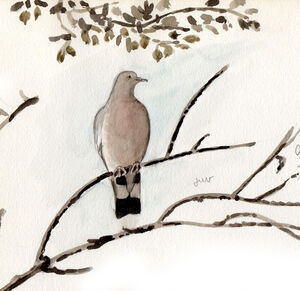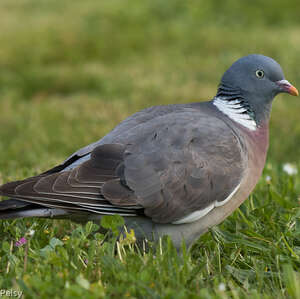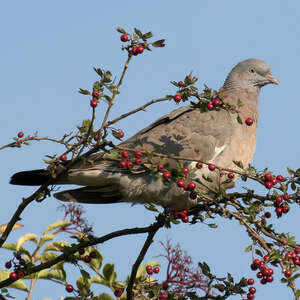Common Wood Pigeon
Columba palumbus - Pigeon ramier
Identification
The Common Wood Pigeon is a large pigeon, the largest in the Western Palearctic. In addition to its large size, it can be recognized by its elongated shape with a long tail, the large white mark that adorns the base of its neck on each side and, in flight, the white band that cuts the wing in the middle at the wrist on the coverings. At rest, it is reduced to a thin white line on the anterior edge of the closed wing. In the adult, the head and upper parts are a fairly light blue-grey. The lower parts are a lighter grey, with a clear violet or mauve tint on the whole chest and neck base. In good light, the sides of the neck are clearly striated. The two white spots stand out in a context of rosy, purple, light green and dark green iridescences, of the most beautiful effect. The remiges are dark grey with whitish beads. The tail is typical. The rectrices are grey above with a large terminal black band. Below, they are striped in the middle of a wide white band, well visible in flight. The iris is very pale yellow, almost white, surrounded by a grey orbital circle. The beak is pink-purple at the base, yellow at its extremity, and the wax is white. The tarsus and toes are pink. The sexes are practically identical. The male on average has more developed white spots on the neck and a more intense chest colour than the female. The 5 described subspecies differ by slight differences in the colour of the plumage and the bare parts. The juvenile is duller than the adult. The top is grey tinted with brown on the wings, with the coverings slightly bordered with beige. The white spot of the neck is absent as well as the iridescent tints. The iris and beak are grey. The legs are greyish pink. Its large size and silhouette prevent confusion with other pigeons, except on the island of Madeira where it lives, or rather lived, with the Trocaz Pigeon, of similar appearance.But the Common Wood Pigeon is the only one to have clear white bands in its wing.
Subspecific information 5 subspecies
- Columba palumbus palumbus (Europe to w Siberia and Iraq; nw Africa)
- Columba palumbus maderensis (Madeira)
- Columba palumbus azorica (e and c Azores)
- Columba palumbus iranica (sw and n Iran to sw Turkmenistan)
- Columba palumbus casiotis (se Iran to Kazakhstan to w China, nw India and Nepal)
Foreign names
- Pigeon ramier,
- Paloma torcaz,
- pombo-torcaz,
- Ringeltaube,
- örvös galamb,
- Houtduif,
- Colombaccio,
- ringduva,
- Ringdue,
- holub hrivnák,
- holub hřivnáč,
- Ringdue,
- sepelkyyhky,
- tudó,
- Hringdúfa,
- grzywacz,
- lauku balodis,
- grivar,
- Вяхирь,
- モリバト,
- 斑尾林鸽,
- ringduva,
- 斑尾林鴿,
Voice song and call
The call of the Common Wood Pigeon is typical and easy to recognize. It is very loud, of a low tonality and slightly hoarse. The basic phrase, which is always the same, can be written as kouh kouh kouhkouh kouh kouhkouh kouhkouh kouh, with the first and last syllables having a tonic accent as if they were suspended. The syllables organize themselves in four similar frequencies. The phrase can be unique or repeated multiple times, depending on the singer's mood. This is the familiar cooing that can be heard everywhere in a woody environment in spring, and even in a city thanks to parks and gardens. The low tonality is capable of passing through a leafy barrier. The territorial cry, of a similar tonality, is a more or less stretched wouhhkouuuh. The couple in the intimacy produces various guttural sounds. Outside of the reproductive period, the species is silent.
Habitat
The Common Wood Pigeon has two habitat requirements. It needs a wooded area for reproduction, though the requirements are relatively low - they can be found nesting in everything from deep forests to garden environments with only a few trees in urban areas.
Behaviour character trait
The Common Wood Pigeon is a monogamous species that reproduces in territorial couples. But once reproduction is completed, it becomes gregarious. It is family groups that come together first to exploit local resources in unison and spend the night in trees. As it is a game species, it is these groups that are subject to harvesting by hunters at the opening of the hunt. The bird's bulky shape and abundance make it a game of choice. The Common Wood Pigeon is a partial migrant. Birds in Western Europe are sedentary or at most erratic, while the populations of Northern, Central, and Eastern Europe, subject to harsh winter conditions, are migratory. In the fall, mainly in October, large flocks, often of several thousand birds, migrate west of the continent to the Mediterranean coast, where they will spend the winter. The passage of the Pyrenees towards Spain is a spectacular phenomenon well known to ornithologists who count the migrants there. They are also expected in the southwest of France, particularly in the Landes, by less well-intentioned people. Dove hunting in sites known as dovecot is a tradition according to which almost anything is allowed in terms of harvesting. Originally, the Common Wood Pigeon is a shy bird towards humans.
But in the recent period, a fraction of the population has evolved towards a certain familiarity with humans, a closeness, probably due to the close link between the bird and agriculture. And the phenomenon is continuing to gain momentum. Some wood pigeons have become completely urban thanks to parks and wooded gardens. They coexist with the many city rock doves without any competition appearing between the two species, which means that they do not exploit the urban environment in the same way.The adaptability of the Common Wood Pigeon to this environment is well illustrated by recent examples of nesting on buildings, such as balconies, window ledges with flower boxes, cornices, and therefore much less hidden than the woodcock, thus also minimizing competition. But what will be the result in the long run? The two species already coexist widely in the agricultural environment where they feed. In an urban environment, these birds find some protection from predators and even from humans as predators, a protection that they do not have or is less in the natural environment. Finally, what does the uninformed public know and perceive of the Common Wood Pigeon? In the spring, there are two manifestations that attract attention. First, the song, very audible and very characteristic. Then there is the mating flight, a very visual and audible demonstration given by the territorial males. It will be described in the following paragraph. During migration, the large flocks of passage are noticeable either when they are actively migrating or when they invade the forests in search of seeds, acorns, beech mast and other things. This of course attracts predators such as the Hobby, a specialized raptor whose presence and action can be guessed from the bursts of Common Wood Pigeons that rise above the canopy to escape him.Flight
The Common Wood Pigeon has an energetic, fast and direct flight. The power of its beats is translated into a continuous hissing sound.
One can imagine the sound atmosphere of a flock of Wood Pigeons on their migration. Both the take off and landing are noisy, due to the flapping of its wings. These can be complementary criteria for identification. The territorial flight is not to be missed. When flaunting, the bird goes up altitude, deliberately making its wings clap loudly, then they reach a high point closed wings and tail spread, then they drop a bit and resumes its normal flight.Dietfeeding habits
The Common Wood Pigeon mostly feeds on the ground on plant matter such as leaves, buds, young shoots, various wild and cultivated seeds, fruits, etc.
It is capable of swallowing a seed as big as an oak acorn or a fruit the size of a cherry. Its diet also contains a minor proportion of invertebrates, worms, larvae and imagos of insects, small molluscs, etc. Agricultural lands provide it with the main part of its diet and when it descends in great numbers in crops, the damage it causes can be considerable.Reproduction nesting
The Common Wood Pigeon has an arboreal nest. It builds its nest at a variable height in a tree or large shrub. This nest is a quite flat structure, 17 to 23 cm in diameter, built on or at the base of a branch, in ivy on a trunk, in a dense shrub, etc. Occasionally, it can make its nest on an urban building, for example sheltered in a flower trough on a balcony or a window sill. This is a recent phenomenon that tends to develop. Its nest has also already been found on the ground in dense vegetation. This nest is made of dry twigs about 20 cm long, intertwined.
Smaller twigs and some grasses give the structure its consistency. But the nest remains quite rudimentary and it can happen that one can see the eggs through it. It is often reused, which increases its thickness. The female lays two white eggs, as is the rule among Columbids. The incubation, which starts with the laying of the first egg, lasts 16 to 17 days. The young, first covered in a yellow down and then with juvenile plumage , will stay in the nest for about a month before they can fly. After the flight, they will stay dependent on the parents for a while. The young are fed by regurgitation from the adult's crop. At first, their exclusive diet consists of a crop secretion called pigeon's milk. This is an adaptation of the Columbids. Then the diet will become gradually vegetarian, the food dish consisting of a gruel prepared in their crop and including the vegetable items consumed by them. In temperate regions, the breeding period extends from the end of February to the beginning of September. A normal second laying is frequent in this species and a third is possible in this time frame. This compensates for the low natural laying size of the species.Geographic range
The Common Wood Pigeon is a species of wooded areas of the Western Palearctic. Its main breeding area extends across Europe to the Ural region to the east, a large part of the Fenno-Scandia and western Siberia to the north, and south to the Maghreb, Turkey, Iraq and northwest Iran. It is mainly occupied by the ssp type palumbus iranica which is located in the southeast, from Iraq to Turkmenistan. There are three disjointed populations on the periphery. Two sedentary island populations, azorica and maderensis, occupy the Azores and Madeira respectively. In the extreme southeast, casiotis has a fragmented area which mainly covers the forests of southern Kazakhstan to Northern Afghanistan and Pakistan as well as the extreme northeast of India. This is the one that can go to winter in the Himalayas. To the south, isolates of this ssp are known in the southeast of Iran and in the Sultanate of Oman where the birds are obviously sedentary.
Threats - protection
IUCN conservation status
concern
in the Wild
threatened
evaluated
The species is not overall threatened. The global population counts several millions of pairs. Despite hunting pressures, the Common Wood Pigeon is abundant in Western Europe. It is given in expansion in several countries and locally considered as an agricultural pest. On the contrary, it is probably in decline in the south and east of its range and hunting pressures probably accentuate the phenomenon. Insular populations are always vulnerable. Therefore, the species is rare in the Azores and has probably disappeared from Madeira.
Sources of information
- IOC World Bird List (v15.1), Gill, F and D Donsker (Eds). 2025-12-07.
Other sources of interest
 Specification sheet created on
10/07/2023 by Jean François
Specification sheet created on
10/07/2023 by Jean FrançoisTranslation by AI Oiseaux.net
© 1996-2025 Oiseaux.net
- Accipitriformes
- Aegotheliformes
- Anseriformes
- Apodiformes
- Apterygiformes
- Bucerotiformes
- Caprimulgiformes
- Cariamiformes
- Casuariiformes
- Charadriiformes
- Ciconiiformes
- Coliiformes
- Columbiformes
- Coraciiformes
- Cuculiformes
- Eurypygiformes
- Falconiformes
- Galliformes
- Gaviiformes
- Gruiformes
- Leptosomiformes
- Mesitornithiformes
- Musophagiformes
- Nyctibiiformes
- Opisthocomiformes
- Otidiformes
- Passeriformes
- Pelecaniformes
- Phaethontiformes
- Phoenicopteriformes
- Piciformes
- Podargiformes
- Podicipediformes
- Procellariiformes
- Psittaciformes
- Pterocliformes
- Rheiformes
- Sphenisciformes
- Steatornithiformes
- Strigiformes
- Struthioniformes
- Suliformes
- Tinamiformes
- Trogoniformes



































